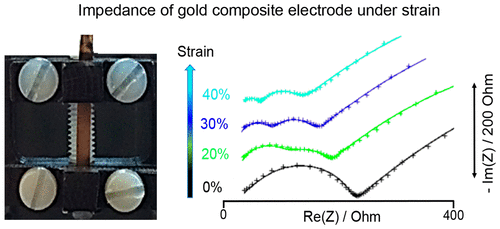Our official English website, www.x-mol.net, welcomes your
feedback! (Note: you will need to create a separate account there.)
Electrochemistry on Stretchable Nanocomposite Electrodes: Dependence on Strain
ACS Nano ( IF 15.8 ) Pub Date : 2018-07-17 00:00:00 , DOI: 10.1021/acsnano.8b03962 Lionel Lopez 1 , Yoonseob Kim 2 , Loic Jierry 1, 3 , Joseph Hemmerle 4, 5 , Fouzia Boulmedais 1 , Pierre Schaaf 3, 4, 5, 6, 7 , Sergey Pronkin 8 , Nicholas A. Kotov 2
ACS Nano ( IF 15.8 ) Pub Date : 2018-07-17 00:00:00 , DOI: 10.1021/acsnano.8b03962 Lionel Lopez 1 , Yoonseob Kim 2 , Loic Jierry 1, 3 , Joseph Hemmerle 4, 5 , Fouzia Boulmedais 1 , Pierre Schaaf 3, 4, 5, 6, 7 , Sergey Pronkin 8 , Nicholas A. Kotov 2
Affiliation

|
Stretchable nanocomposite conductors are essential for engineering of bio-inspired deformable electronics, human–machine interfaces, and energy storage devices. While the effect of strain on conductivity for stretchable conductors has been thoroughly investigated, the strain dependence of multiple other electrical-transport processes and parameters that determine the functionalities and biocompatibility of deformable electrodes has received virtually no attention. The constancy of electrochemical parameters at electrode–fluid interfaces such as redox potentials, impedances, and charge-transfer rate constants on strain is often tacitly assumed. However, it remains unknown whether these foundational assumptions actually hold true for deformable electrodes. Furthermore, it is also unknown whether the previously used charge-transport circuits describing electrochemical processes on rigid electrodes are applicable to deformable electrodes. Here, we investigate the validity of the strain invariability assumptions for an elastic composite electrode based on gold nanoparticles (AuNPs). A comprehensive model of electrode reactions that accurately describes electrochemical processes taking place on nanocomposite electrodes for ferro-/ferricyanide electrochemicals pair at different strains is developed. Unlike rigid gold electrodes, the model circuit for stretchable electrodes is comprised of two parallel impedance segments describing (a) diffusion and redox processes taking place on the open surface of the composite electrode and (b) redox processes that occur in nanopores. AuNPs forming the open-surface circuit support the redox process, whereas those forming the nanopores only increase the double-layer capacitance. The redox potential was found to be strain-independent for tensile deformations as high as 40%. Other parameters, however, display strong strain dependence, exemplified by the 2–2.5 and 27 times increases of active area of the open and nanopore surface area, respectively, after application of 40% strain. Gaining better understanding of the strain-dependent and -independent electrochemical parameters enables both fundamental and practical advances in technologies based on deformable electrodes.
中文翻译:

可拉伸纳米复合电极上的电化学:取决于应变。
可拉伸的纳米复合导体对于生物启发的可变形电子产品,人机界面和能量存储设备的工程设计至关重要。尽管已经对应变对可拉伸导体的电导率的影响进行了彻底的研究,但确定可变形电极的功能和生物相容性的多种其他电传输过程和参数对应变的依赖性几乎没有引起关注。通常默认地认为电极-流体界面处的电化学参数是恒定的,例如氧化还原电势,阻抗和电荷转移速率常数对应变的影响。但是,对于可变形电极,这些基础假设是否真的成立,仍然是未知的。此外,同样未知的是,先前使用的描述刚性电极上的电化学过程的电荷传输电路是否适用于可变形电极。在这里,我们调查基于金纳米粒子(AuNPs)的弹性复合电极应变不变性假设的有效性。建立了一个电极反应的综合模型,该模型准确地描述了在不同应变下,铁/铁氰化物电化学对在纳米复合电极上发生的电化学过程。与刚性金电极不同,用于可拉伸电极的模型电路由两个平行的阻抗段组成,描述了(a)在复合电极的开放表面上发生的扩散和氧化还原过程,以及(b)在纳米孔中发生的氧化还原过程。形成开放表面电路的AuNP支持氧化还原过程,而形成纳米孔的AuNP仅增加双层电容。发现对于高达40%的拉伸变形,氧化还原电势与应变无关。然而,其他参数显示出很强的应变依赖性,例如,施加40%应变后,开孔和纳米孔表面积的有效面积分别增加2–2.5和27倍。对应变依赖性和非依赖性电化学参数的更好的理解使得基于可变形电极的技术的基础和实际进展都得到了发展。然而,表现出强烈的应变依赖性,例如,施加40%应变后,开孔活性面积和纳米孔表面积的活性面积分别增加2–2.5和27倍。对应变依赖性和非依赖性电化学参数的更好的理解使得基于可变形电极的技术的基础和实际进展都得到了发展。然而,表现出强烈的应变依赖性,例如,施加40%应变后,开孔活性面积和纳米孔表面积的活性面积分别增加2–2.5和27倍。对应变依赖性和非依赖性电化学参数的更好的理解使得基于可变形电极的技术的基础和实践上的进步。
更新日期:2018-07-17
中文翻译:

可拉伸纳米复合电极上的电化学:取决于应变。
可拉伸的纳米复合导体对于生物启发的可变形电子产品,人机界面和能量存储设备的工程设计至关重要。尽管已经对应变对可拉伸导体的电导率的影响进行了彻底的研究,但确定可变形电极的功能和生物相容性的多种其他电传输过程和参数对应变的依赖性几乎没有引起关注。通常默认地认为电极-流体界面处的电化学参数是恒定的,例如氧化还原电势,阻抗和电荷转移速率常数对应变的影响。但是,对于可变形电极,这些基础假设是否真的成立,仍然是未知的。此外,同样未知的是,先前使用的描述刚性电极上的电化学过程的电荷传输电路是否适用于可变形电极。在这里,我们调查基于金纳米粒子(AuNPs)的弹性复合电极应变不变性假设的有效性。建立了一个电极反应的综合模型,该模型准确地描述了在不同应变下,铁/铁氰化物电化学对在纳米复合电极上发生的电化学过程。与刚性金电极不同,用于可拉伸电极的模型电路由两个平行的阻抗段组成,描述了(a)在复合电极的开放表面上发生的扩散和氧化还原过程,以及(b)在纳米孔中发生的氧化还原过程。形成开放表面电路的AuNP支持氧化还原过程,而形成纳米孔的AuNP仅增加双层电容。发现对于高达40%的拉伸变形,氧化还原电势与应变无关。然而,其他参数显示出很强的应变依赖性,例如,施加40%应变后,开孔和纳米孔表面积的有效面积分别增加2–2.5和27倍。对应变依赖性和非依赖性电化学参数的更好的理解使得基于可变形电极的技术的基础和实际进展都得到了发展。然而,表现出强烈的应变依赖性,例如,施加40%应变后,开孔活性面积和纳米孔表面积的活性面积分别增加2–2.5和27倍。对应变依赖性和非依赖性电化学参数的更好的理解使得基于可变形电极的技术的基础和实际进展都得到了发展。然而,表现出强烈的应变依赖性,例如,施加40%应变后,开孔活性面积和纳米孔表面积的活性面积分别增加2–2.5和27倍。对应变依赖性和非依赖性电化学参数的更好的理解使得基于可变形电极的技术的基础和实践上的进步。









































 京公网安备 11010802027423号
京公网安备 11010802027423号